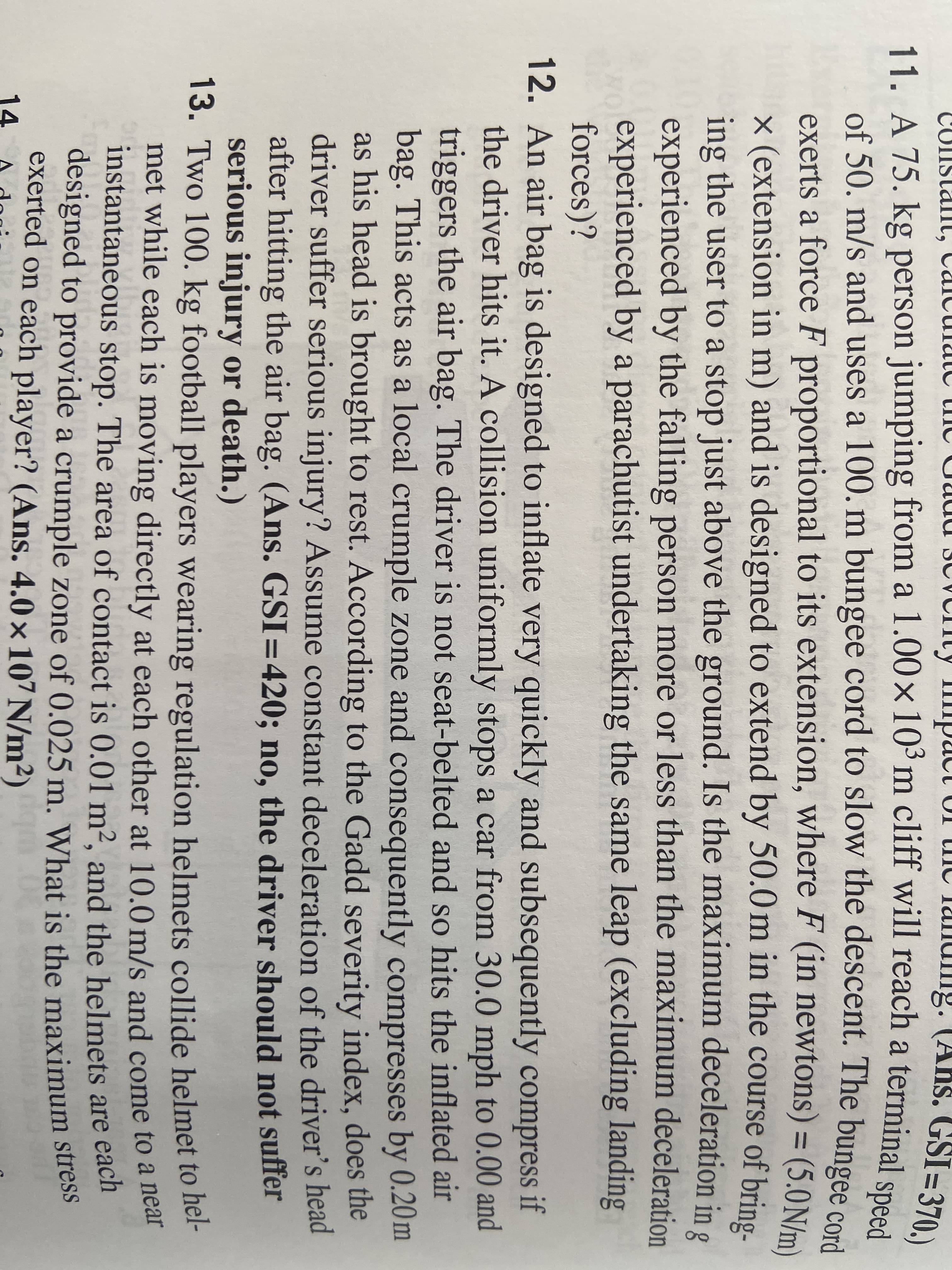ns. GSI=370.) 11. A 75. kg person jumping from a 1.00×10°m cliff will reach a terminal spoi of 50. m/s and uses a 100. m bungee cord to slow the descent. The bungee exerts a force F proportional to its extension, where F (in newtons) = (5.ONm × (extension in m) and is designed to extend by 50.0m in the course of bring- ing the user to a stop just above the ground. Is the maximum deceleration in e experienced by the falling person more or less than the maximum deceleration experienced by a parachutist undertaking the same leap (excluding landing forces)? 12. An air bag is designed to inflate very quickly and subsequently compress if the driver hits it. A collision uniformly stops a car from 30.0 mph to 0.00 and triggers the air bag. The driver is not seat-belted and so hits the inflated air bag. This acts as a local crumple zone and consequently compresses by 0.20m as his head is brought to rest. According to the Gadd severity index, does the driver suffer serious injury? Assume constant deceleration of the driver's head after hitting the air bag. (Ans. GSI=420; no, the driver should not suffer serious injury or death.) 13. Two 100. kg football players wearing regulation helmets collide helmet to hel- met while each is moving directly at each other at 10.0 m/s and come to a near instantaneous stop. The area of contact is 0.01 m²2 and the helmets are each" 3(5.0N/m) %3D %3D designed to provide a crumple zone of 0.025 m. What is the maximum stress exerted on each player? (Ans. 4.0 × 107 N/m²) 14 A dogi
ns. GSI=370.) 11. A 75. kg person jumping from a 1.00×10°m cliff will reach a terminal spoi of 50. m/s and uses a 100. m bungee cord to slow the descent. The bungee exerts a force F proportional to its extension, where F (in newtons) = (5.ONm × (extension in m) and is designed to extend by 50.0m in the course of bring- ing the user to a stop just above the ground. Is the maximum deceleration in e experienced by the falling person more or less than the maximum deceleration experienced by a parachutist undertaking the same leap (excluding landing forces)? 12. An air bag is designed to inflate very quickly and subsequently compress if the driver hits it. A collision uniformly stops a car from 30.0 mph to 0.00 and triggers the air bag. The driver is not seat-belted and so hits the inflated air bag. This acts as a local crumple zone and consequently compresses by 0.20m as his head is brought to rest. According to the Gadd severity index, does the driver suffer serious injury? Assume constant deceleration of the driver's head after hitting the air bag. (Ans. GSI=420; no, the driver should not suffer serious injury or death.) 13. Two 100. kg football players wearing regulation helmets collide helmet to hel- met while each is moving directly at each other at 10.0 m/s and come to a near instantaneous stop. The area of contact is 0.01 m²2 and the helmets are each" 3(5.0N/m) %3D %3D designed to provide a crumple zone of 0.025 m. What is the maximum stress exerted on each player? (Ans. 4.0 × 107 N/m²) 14 A dogi
Principles of Heat Transfer (Activate Learning with these NEW titles from Engineering!)
8th Edition
ISBN:9781305387102
Author:Kreith, Frank; Manglik, Raj M.
Publisher:Kreith, Frank; Manglik, Raj M.
Chapter11: Heat Transfer By Radiation
Section: Chapter Questions
Problem 11.12P
Related questions
Question
Bioengineering Q11

Transcribed Image Text:ns.
GSI=370.)
11. A 75. kg person jumping from a 1.00×10°m cliff will reach a terminal spoi
of 50. m/s and uses a 100. m bungee cord to slow the descent. The bungee
exerts a force F proportional to its extension, where F (in newtons) = (5.ONm
× (extension in m) and is designed to extend by 50.0m in the course of bring-
ing the user to a stop just above the ground. Is the maximum deceleration in e
experienced by the falling person more or less than the maximum deceleration
experienced by a parachutist undertaking the same leap (excluding landing
forces)?
12. An air bag is designed to inflate very quickly and subsequently compress if
the driver hits it. A collision uniformly stops a car from 30.0 mph to 0.00 and
triggers the air bag. The driver is not seat-belted and so hits the inflated air
bag. This acts as a local crumple zone and consequently compresses by 0.20m
as his head is brought to rest. According to the Gadd severity index, does the
driver suffer serious injury? Assume constant deceleration of the driver's head
after hitting the air bag. (Ans. GSI=420; no, the driver should not suffer
serious injury or death.)
13. Two 100. kg football players wearing regulation helmets collide helmet to hel-
met while each is moving directly at each other at 10.0 m/s and come to a near
instantaneous stop. The area of contact is 0.01 m²2 and the helmets are each"
3(5.0N/m)
%3D
%3D
designed to provide a crumple zone of 0.025 m. What is the maximum stress
exerted on each player? (Ans. 4.0 × 107 N/m²)
14
A dogi
Expert Solution
This question has been solved!
Explore an expertly crafted, step-by-step solution for a thorough understanding of key concepts.
Step by step
Solved in 3 steps with 4 images

Knowledge Booster
Learn more about
Need a deep-dive on the concept behind this application? Look no further. Learn more about this topic, mechanical-engineering and related others by exploring similar questions and additional content below.Recommended textbooks for you

Principles of Heat Transfer (Activate Learning wi…
Mechanical Engineering
ISBN:
9781305387102
Author:
Kreith, Frank; Manglik, Raj M.
Publisher:
Cengage Learning

Principles of Heat Transfer (Activate Learning wi…
Mechanical Engineering
ISBN:
9781305387102
Author:
Kreith, Frank; Manglik, Raj M.
Publisher:
Cengage Learning